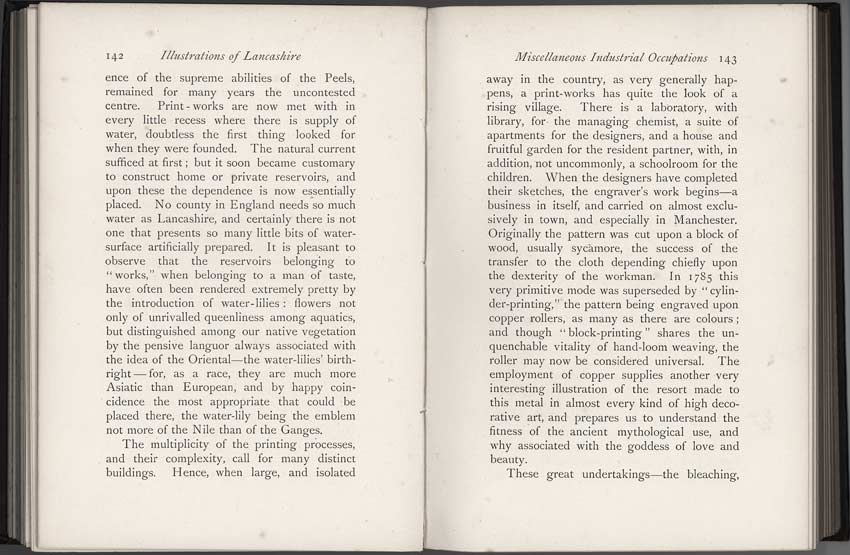
Scan and page transcript from:
LANCASHIRE - Brief Historical and Descriptive Notes
by Leo H. Grindon
Pub. 1892
pages 142-143 |
142 Illustrations of Lancashire ence of the supreme abilities of the Peels, remained for many years the uncontested centre. Print-works are now met with in every little recess where there is supply of water, doubtless the first thing looked for when they were founded. The natural current sufficed at first; but it soon became customary to construct home or private reservoirs, and upon these the dependence is now essentially placed. No county in England needs so much water as Lancashire, and certainly there is not one that presents so many little bits, of water-surface artificially prepared. It is pleasant to observe that the reservoirs belonging to "works," when belonging to a man of taste, have often been rendered extremely pretty by the introduction of water-lilies: flowers not only of unrivalled queenliness among aquatics, but distinguished among our native vegetation by the pensive languor always associated with the idea of the Oriental - the water-lilies' birthright - for, as a race, they are much more , Asiatic than European, and by happy coincidence the most appropriate that could ·be placed there, the water-lily being the emblem not more of the Nile than of the Ganges. |
Miscellaneous Industrial Occupations 143 away in the country, as very generally happens, a print-works has quite the look of a rising village. There is a laboratory, with library, for the managing chemist, a suite of apartments for the designers, and a house and fruitful garden for the resident partner, with, in addition, not uncommonly, a schoolroom for the children. When the designers have completed their sketches, the engraver's work begins - a business in itself, and carried on almost exclusively in town, and especially in Manchester. Originally the pattern was cut upon a block of wood, usually sycamore, the success of the transfer to the cloth depending chiefly upon the dexterity of the workman. In 1785 this very primitive mode was superseded by "cylin der-printing," the pattern being engraved upon copper rollers, as many as there are colours; and though "block-printing" shares the unquenchable vitality of hand-loom weaving, the roller may now be considered universal. The employment of copper supplies another very interesting illustration of the resort made to this metal in almost every kind of high decorative art, and prepares us to understand the fitness of the ancient mythological use, and why associated with the goddess of love and beauty. |
